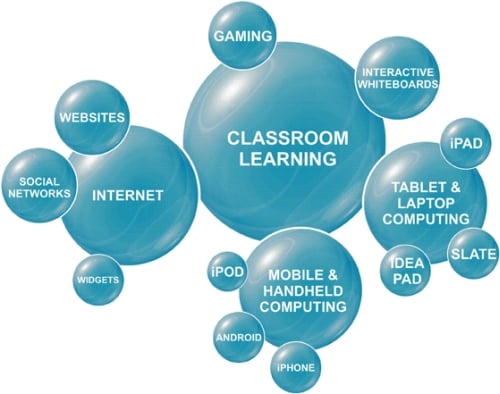The Blended Learning Cycle by Haley Torries
BOZEMANSCIENCE , by Mr. Paul Andersen, is a science blog with educational videos, notes and video translations. In one of the videos, Blended Learning Cycle, he describes the full process and essentials of his Blended Learning Cycle. It starts with the components of online, mobile and classroom by blending them into one. Then he adds five e's in this learning cycle; engage, explore, explain, expand and evaluate. First, he engages the students with an engaging question. Then, he allows the students to explore all of the possibilities of the answer. After they explore, he explains the answer by expanding it. Finally, the question and answer gets evaluated. All of these components make up the Blended Learning Cycle.

He uses the acronym QUIVERS with a picture of a quiver holding six bows. The bows signify his six ideas. The QU in QUIVERS stands for the question given to the class. The I stands for the student doing an investigation needed to find the answer. V stands for the independent videos the students watch. The E stands for elaboration, so the students have a chance to expand the information on the subject. R stands for review. The teacher goes around the room to each group individually to make sure each student understands the answer. The last letter is S because this is the summary quiz, which the students are not allowed to take until the teacher knows they understand the subject. This cycle would be beneficial for a teacher to use in a classroom.
Making Thinking Visible by Kaitlyn Parker
by Paula Lu
In the TED video "Brian Crosby - Back to the Future," Brian Crosby, an elementary teacher in Sparks, Nevada, talks about his 4th grade class and their want to learn. His 4th grade class consist of second language learners and students living in poverty. On the second day of school he surveyed his students on things that I believe most 4th graders should know. Out of twenty-four 4th graders, only 9 knew what city they lived in, 12 knew what state they live in, and only 3 knew what country they lived in. Less than half the students knew their address and very few knew their home phone number or did not have one. In his classroom, each student has a laptop and each of them have a blog. These kids are building learning networks and the feedback they receive makes them happy.
One of the experiments he did with his students was the balloon project. He used this project to teach them what they needed to know. The balloon project taught them imagination and creativity, and also about the atmosphere, which was a standard. A video camera was attached to the balloon when it was released. It allowed to students to see what happened as the balloon floated higher into the atmosphere and what happened when it had floated to high. He asked his students to write a story about being the balloon describing what was happening.
He says, "We have been teaching kids how to be taught, to raise their hand when they want to ask a question, but that is changing." We are empowering kids to want to learn on their own. They get to connect to the world and collaborate with classmates and others. Technology is changing the way students are being taught. In one of his classes, he had a student learning through her computer at home because she was ill. She became a part of his class. He says that we should stop racing kids through school, that it is not a race. Everything that we are doing should be providing them with opportunities.

My Thoughts
It was really surprising to me that these students did not know this information about where they live and such, but knowing their background, I can understand why. When I was a 4th grader I knew what city I lived in, my home phone number, my address, what country I lived in, all of that. In a way, I guess I was force to know this information for emergency purposes. I really enjoyed watching this video. I want to be able to teach this way in the future. I want to make learning fun for my students just like Brian Crosby does. With the balloon project, he used it to teach them what they needed to know as well as spark their creativity. It is like killing two birds with one stone. He has them creating videos, posting them to their blog, and have them explain what, why, and how it happened. He made learning fun. He sparked their curiosity and made them want to learn. From the video, he did an experiment with a can that when it got close to this liquid, the pressure dropped and the can implodes. I am actually still trying to figure out why and how that happened. He even had me curious. I remember in elementary school we never did stuff like this. I do not even remember doing many experiments. Technology is really changing things, but I think it is for the better.

Haley,
ReplyDeleteGreat job this week! You and your group members did a great job summarizing the posts. All the links are working as well as the Alt and Title modifiers!
Keep up the good work.
Melissa Canterbury
Your summary was very good of Mr. Anderson's approach to teaching. How will his ideas affect your teaching?
ReplyDeleteI agree with the Doctor! You gave a great summary but it needs more elaboration, just as you mentioned Mr. Anderson requires of his students. Tell us what parts of it you would use in your classroom and why, how you think it would be beneficial, etc. Be descriptive of how it could be effective when tailored to your classroom, not just in general.
ReplyDeleteKeep up the good work and don't forget to add personal detail!
Carly